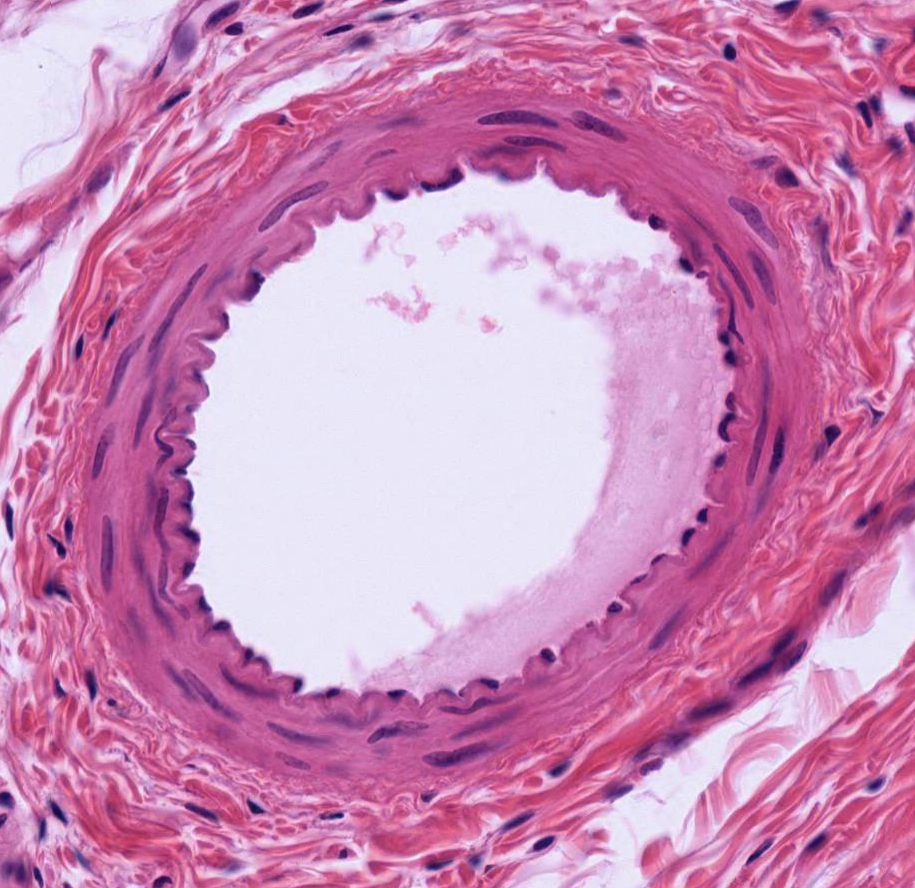Blood Vessels
 Vessels of both the arterial and venous system are classified on the basis of their size, and by the nature and abundance of the tissue composing their tunics. You should be able to distinguish between arteries and veins and recognize capillaries. Remember that red blood cells are often visible in the lumen of blood vessels, however they will not be present in every lumen due to preparation of the slides. Do not depend on red blood cells when identifying blood vessels.
Vessels of both the arterial and venous system are classified on the basis of their size, and by the nature and abundance of the tissue composing their tunics. You should be able to distinguish between arteries and veins and recognize capillaries. Remember that red blood cells are often visible in the lumen of blood vessels, however they will not be present in every lumen due to preparation of the slides. Do not depend on red blood cells when identifying blood vessels.
Larger vessels have a common structural plan in that they are composed of three concentric coats or tunics. These are:
- Tunica intima. This consists of the endothelial lining and its basement membrane, and a delicate layer of loose subendothelial connective tissue. The endothelial lining is diagnostic in distinguishing blood vessels. The nuclei of the simple squamous epithelial cells of the endothelium protrude into the lumen of the vessel. In arteries and arterioles, an internal elastic lamina delimits the outer margin of the tunica intima.
- Tunica media. This layer is composed predominantly of circularly arranged smooth muscle fibers, and there may be a variable amount of reticular and elastic fibers.
- Tunica adventitia. This coat consists predominantly of fibroelastic connective tissue whose fibers generally occur in a longitudinal array. In larger muscular arteries, there is frequently an external elastic membrane separating the tunica adventitia from the tunica media.
DISTINGUISHING FEATURES
 # Arteries have an internal elastic membrane is always present (although it is less distinctive in large elastic arteries). The tunica media is the thickest tunic. It is predominantly muscular in arterioles and most arteries, but it is predominantly elastic in the largest arteries (the so-called elastic arteries such as the aorta and the common carotid). The tunica adventitia is relatively thin.
# Arteries have an internal elastic membrane is always present (although it is less distinctive in large elastic arteries). The tunica media is the thickest tunic. It is predominantly muscular in arterioles and most arteries, but it is predominantly elastic in the largest arteries (the so-called elastic arteries such as the aorta and the common carotid). The tunica adventitia is relatively thin.
- Veins do not have an internal elastic membrane. The tunica media is relatively thin. The tunica adventitia is the thickest tunic and there is no external elastic membrane.
An artery and vein frequently run together, which facilitates their comparison. A useful generalization is that the artery has a relatively thick wall and a small lumen, whereas a vein has a relatively thin wall and a broad lumen.
# Arterioles and small arteries exhibit a distinctive arrangement of endothelial cells and smooth muscle fibers in their walls. The endothelial cells are oriented longitudinally, whereas the smooth muscle fibers in the adjacent tunica media are wrapped around these vessels in a circular fashion. This gives rise to a regular pattern of nuclear orientation that is lacking in venous vessels. An arteriole usually has only one layer of smooth muscle and not more than two.
 # Capillaries are the easiest vessels to define (but not to find). They consist of an endothelial layer and its underlying basal lamina. There may also be an associated pericyte within the basal lamina of the endothelial cell. They are classified on the basis of their "leakiness" as continuous (e.g., muscle, central nervous system, lungs), fenestrated (e.g., endocrine glands, intestinal tract, gall bladder), and discontinuous or sinusoidal (e.g., spleen, bone marrow, liver).
# Capillaries are the easiest vessels to define (but not to find). They consist of an endothelial layer and its underlying basal lamina. There may also be an associated pericyte within the basal lamina of the endothelial cell. They are classified on the basis of their "leakiness" as continuous (e.g., muscle, central nervous system, lungs), fenestrated (e.g., endocrine glands, intestinal tract, gall bladder), and discontinuous or sinusoidal (e.g., spleen, bone marrow, liver).
Use electron micrographs to compare the structure of various types of capillaries.